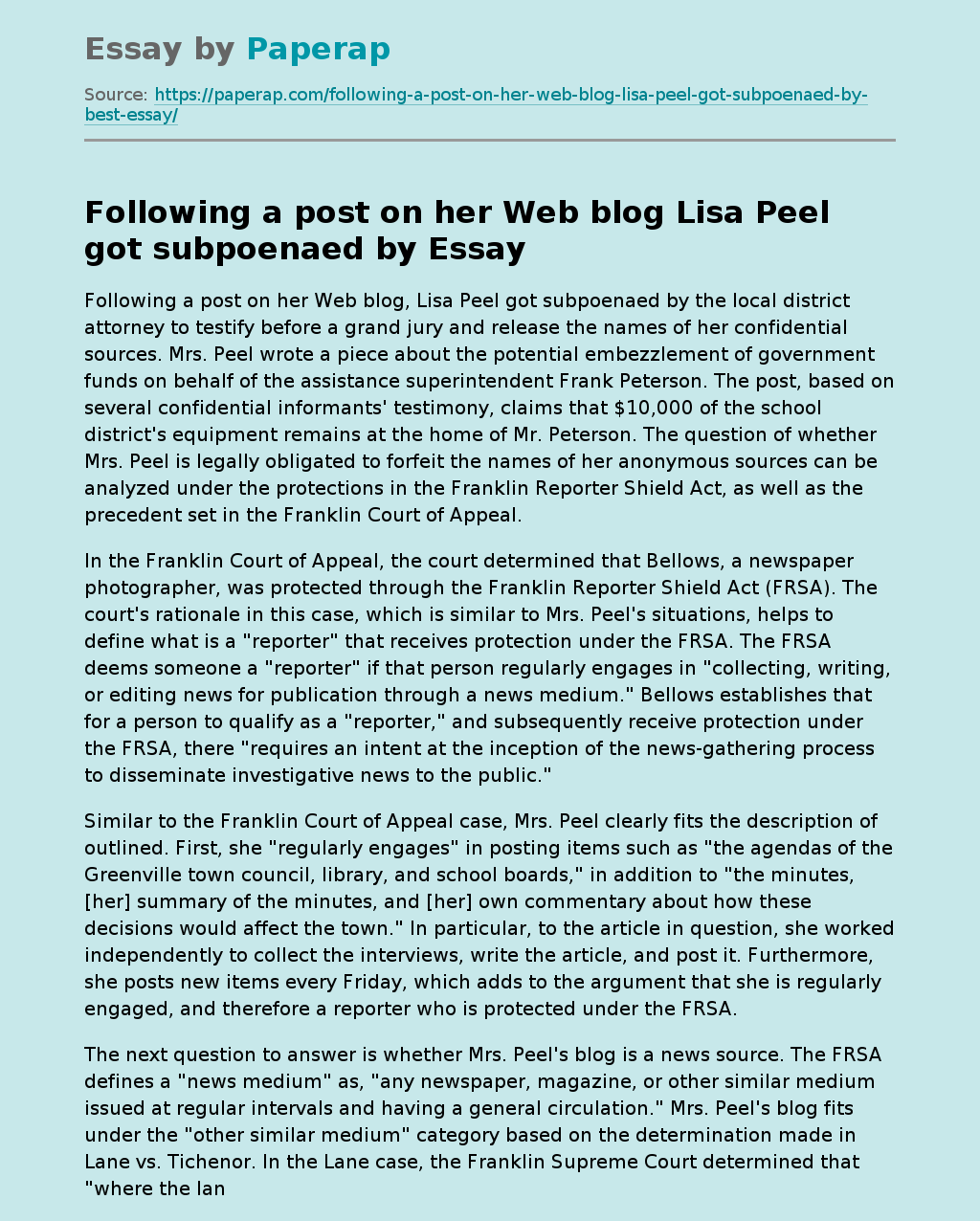Following a post on her Web blog Lisa Peel got subpoenaed by
Following a post on her Web blog, Lisa Peel got subpoenaed by the local district attorney to testify before a grand jury and release the names of her confidential sources. Mrs. Peel wrote a piece about the potential embezzlement of government funds on behalf of the assistance superintendent Frank Peterson. The post, based on several confidential informants’ testimony, claims that $10,000 of the school district’s equipment remains at the home of Mr. Peterson. The question of whether Mrs. Peel is legally obligated to forfeit the names of her anonymous sources can be analyzed under the protections in the Franklin Reporter Shield Act, as well as the precedent set in the Franklin Court of Appeal.
In the Franklin Court of Appeal, the court determined that Bellows, a newspaper photographer, was protected through the Franklin Reporter Shield Act (FRSA). The court’s rationale in this case, which is similar to Mrs. Peel’s situations, helps to define what is a “reporter” that receives protection under the FRSA.
The FRSA deems someone a “reporter” if that person regularly engages in “collecting, writing, or editing news for publication through a news medium.” Bellows establishes that for a person to qualify as a “reporter,” and subsequently receive protection under the FRSA, there “requires an intent at the inception of the news-gathering process to disseminate investigative news to the public.”
Similar to the Franklin Court of Appeal case, Mrs. Peel clearly fits the description of outlined. First, she “regularly engages” in posting items such as “the agendas of the Greenville town council, library, and school boards,” in addition to “the minutes, [her] summary of the minutes, and [her] own commentary about how these decisions would affect the town.
” In particular, to the article in question, she worked independently to collect the interviews, write the article, and post it. Furthermore, she posts new items every Friday, which adds to the argument that she is regularly engaged, and therefore a reporter who is protected under the FRSA.
The next question to answer is whether Mrs. Peel’s blog is a news source. The FRSA defines a “news medium” as, “any newspaper, magazine, or other similar medium issued at regular intervals and having a general circulation.” Mrs. Peel’s blog fits under the “other similar medium” category based on the determination made in Lane vs. Tichenor. In the Lane case, the Franklin Supreme Court determined that “where the language of a statute is unclear, the court may avail itself of external aids to interpret the statute.” For example, The American Heritage Dictionary of the English Language defines “circulation” as “the condition of being…widely known.” Mrs. Peel’s blog is widely known because it is the only means of receiving information other than the one daily paper, and her blog has 3,500 registrants with more than 15,000 views. Therefore Mrs. Peel’s blog should be viewed as a “news medium” based on the interpretation from Lane.
Applying the analysis from Lane to the Franklin Reporter Shield Act’s vagueness about what exactly is “other similar mediums.” As described in the America Today article titled, “Blogs Competing with Newspapers and Networks” where they define blogging as “just another development in journalism” that has transitioned into the new vehicle to obtain public information. Further adding to the argument that Mrs. Peel’s blog fitting under the definition provided in the FRSA.
The principle of ejusdem generis states that “when general words follow particular and specific words in a statute, the general words must be construed to include only things of the same general kind as those indicated by the particular and specific words.” Lane’s ruling can apply to the wording contained in the FRSA, such as “other similar medium,” which does not indicate what exactly fits under that description. Under the FRSA, examples of other similar mediums include radio stations and TV stations. Therefore if Mrs. Peel’s blog can draw a parallel to one of the other medium listed, then she can gain protection through the FRSA. Much like a TV station, Mrs. Peel’s blog covers day to day activities such as her pets and travel, in addition to producing newsworthy content like her blog post. Mrs. Peel can contend despite her blog not being dedicated to newsworthy information that based on the inclusion of the terminology of “other mediums,” her blog can still be protected.
In the preamble of the Franklin Reporter Shield Act, the act argues that its primary purpose is to ensure the free flow of public information to the public and safeguard the media’s ability to gather news. Mrs. Peel, as one of the only sources of noteworthy news in her city, should not be compelled by the state to release the names of her informants. In so far as she is the only counterbalance to the dominant newspaper in her city, it is crucial for the marketplace of ideas, that potential whistleblowers have faith in her ability to keep their identities anonymous. If she is unable to protect their identities, the free flow of information will cease contradicting the very essence of the FRSA itself.
Following a post on her Web blog Lisa Peel got subpoenaed by. (2019, Dec 07). Retrieved from https://paperap.com/following-a-post-on-her-web-blog-lisa-peel-got-subpoenaed-by-best-essay/

